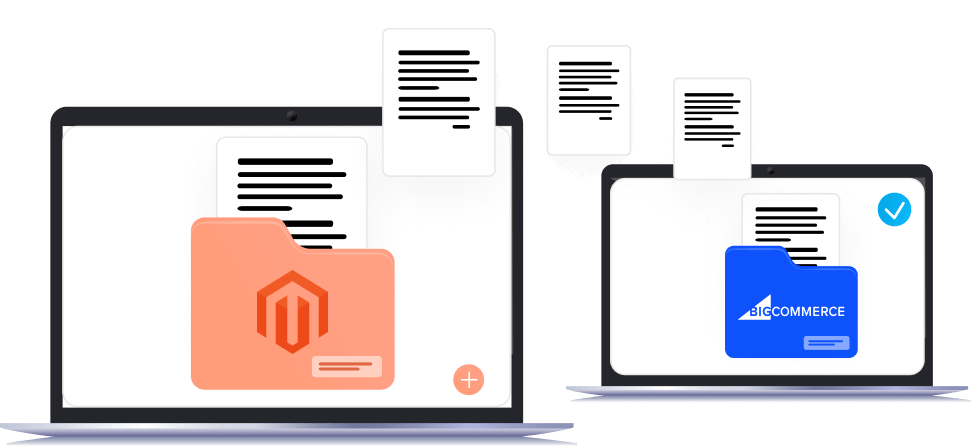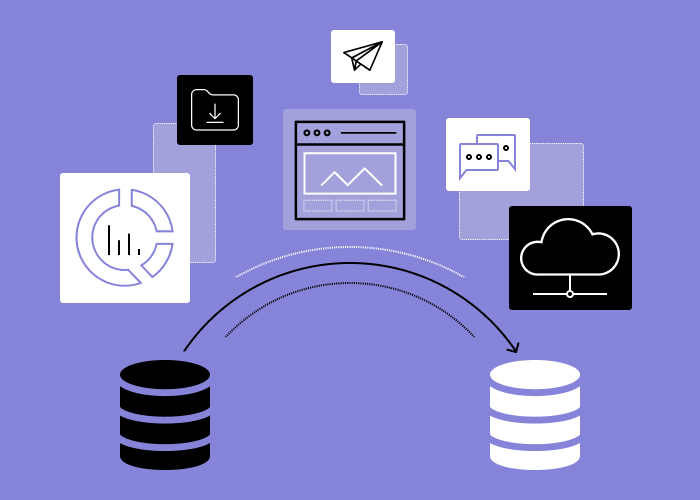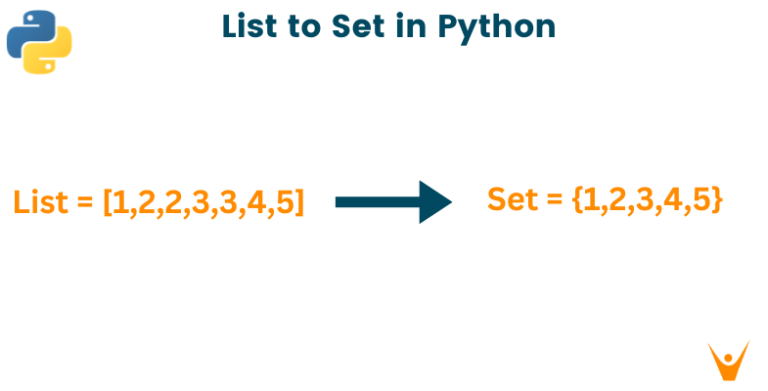Magento to BigCommerce Migration: A Step-by-Step Guide for Beginners
Are you looking for a scalable, flexible, and cost-effective platform for your online store? If you are currently using Magento, you might be wondering how to migrate your data and store settings to BigCommerce, a leading SaaS ecommerce solution. In this article, we will show you how to perform a Magento to BigCommerce migration in a few simple steps, without losing any of your valuable data or compromising your store performance.
What is Magento to BigCommerce Migration?
Migration from Magento to BigCommerce involves transferring your ecommerce data and configurations from Magento, a self-hosted platform, to BigCommerce, a cloud-based solution. This transition offers the opportunity to adopt a more scalable, secure, and cost-effective ecommerce platform tailored to your business requirements.

Various methods and tools facilitate the migration process:
– Catalog Transfer App: This free application allows for the transfer of up to 1,000 products, categories, and customers from Magento to BigCommerce. Users input their Magento database credentials and select the data to migrate.
– CSV Import: A manual method involving the export of Magento data to CSV files, which are then imported into BigCommerce via the control panel. Users must ensure CSV files conform to BigCommerce’s format and fields.
– Managed Transfer: A professional service that transfers all Magento data, including orders, coupons, and reviews, to BigCommerce. Users provide Magento store URL and admin credentials, with migration managed by a BigCommerce engineer.
Before proceeding with Magento to BigCommerce migration, careful planning and preparation of data and settings are essential. Setting up the BigCommerce store and conducting thorough testing of the new site are recommended prior to launch.
Why Migrate from Magento to BigCommerce?
Magento is a strong ecommerce platform, but it has its downsides. It needs a bunch of technical skills, plus costs for upkeep and hosting, which can be tough for small to medium-sized businesses. Also, Magento is hard to learn and has complicated code, making it tough and time-consuming to customize and integrate.
BigCommerce is a cloud-based online selling platform that brings many advantages to sellers. It’s easy to use, packed with features, and has a strong API for customizing your store. Plus, BigCommerce handles hosting, security, and PCI compliance, freeing you to concentrate on business growth. Compared to Magento, BigCommerce offers lower overall costs and can grow with your business effortlessly.
How to Migrate from Magento to BigCommerce?
There are several options for migrating your data from Magento to BigCommerce, depending on your budget, time, and technical skills. You can use one of the following methods:
- Catalog Transfer app: A free app that allows you to transfer up to 1,000 products, categories, and customers from Magento to BigCommerce. This app is ideal for small to mid-sized stores with simple catalogs.
- CSV Import: A manual method that requires you to export your data from Magento and import it to BigCommerce using CSV files. This method is suitable for stores with larger catalogs and more complex data structures.
- Managed Transfer: A professional service that involves BigCommerce engineers transferring your data, store settings, and design elements from Magento to BigCommerce. This service is recommended for stores with very large and complex catalogs, or those who want a hassle-free migration.
Step 1: Pre-Migration Planning
Before you start your migration, you need to do some planning and preparation to ensure a smooth and successful process. Here are some things you need to do:
- Back up your Magento store: Make a copy of your Magento database and files, in case you need to restore them later.
- Choose a BigCommerce plan: Compare the different BigCommerce plans and choose the one that suits your business needs and budget. You can commence with a complimentary trial and then opt to upgrade subsequently.
- Set up your BigCommerce store: Create your BigCommerce account and store, and choose a theme and domain name for your new site.
- Review your Magento data: Check your Magento data for any errors, duplicates, or missing information. You may also want to delete any unnecessary or outdated data to optimize your migration.
- Map your data fields: Identify the data fields that you want to transfer from Magento to BigCommerce, and match them with the corresponding fields in BigCommerce. You may need to edit or format your data to make it compatible with BigCommerce.
Step 2: Set Up Your BigCommerce Store
After you have planned your migration, you need to set up your BigCommerce store and make it ready for receiving your Magento data. Here are some steps you need to follow:
- Install the Catalog Transfer app: If you are using the Catalog Transfer app to migrate your data, you need to install it from the BigCommerce App Marketplace. You will also need to provide your Magento database credentials to connect the app with your Magento store.
- Configure your store settings: Go to your BigCommerce dashboard and adjust your store settings, such as currency, tax, shipping, payment, and checkout options. You can also enable or disable certain features, such as product reviews, wish lists, and gift certificates.
- Customize your store design: Choose a theme for your BigCommerce store from the Theme Marketplace, or create your own custom theme using the Stencil framework. You can also use the Store Design tool to modify your theme settings, such as colors, fonts, and layout.
Step 3: Export Your Magento Data
The next step is to export your data from Magento and prepare it for import to BigCommerce. Depending on the method you are using, you may need to do one of the following:
- Run the Catalog Transfer app: If you are using the Catalog Transfer app, you just need to run the app and select the data types that you want to transfer. The app will automatically copy your products, categories, and customers from Magento to BigCommerce. You can monitor the progress of the transfer on the app dashboard.
- Export CSV files: If you are using the CSV import method, you need to export your data from Magento to CSV files. You can use the Magento Dataflow Profiles tool to export your products, categories, and customers. You may also need to export your orders, coupons, and reviews separately, using third-party extensions or tools.
Step 4: Import Your Data to BigCommerce
The final step is to import your data to BigCommerce and verify that everything is transferred correctly. Depending on the method you are using, you may need to do one of the following:
- Verify the Catalog Transfer app results: If you are using the Catalog Transfer app, you just need to check your BigCommerce store and make sure that your products, categories, and customers are imported correctly. You may also need to do some post-migration cleanup, such as reorganizing your categories, merging your product descriptions, or updating your product options.
- Import CSV files: If you choose the CSV import method, you’ll use the import tools in your BigCommerce dashboard to bring in your CSV files. You can bring in your products, categories, and customers with the tools provided. To bring in orders, coupons, and reviews, you might need to use third-party apps. Make sure your CSV files match BigCommerce’s format before importing by editing or formatting them as needed.
Step 5: Set Up Redirects
After moving your data, it’s crucial to make sure your old Magento website links go to the right places on your new BigCommerce site. This stops broken links, errors, or problems with search engine ranking. BigCommerce has a tool for setting up redirects, so you can make sure all your products, categories, and pages go to the right spots. You can also use other apps or tools to do this in bulk. And if you haven’t already, update your domain settings to point to your new BigCommerce store.
Step 6: Test Your New Site
Before you launch your new BigCommerce site, you should test it thoroughly and make sure that everything is working properly. Here are some things you should check:
- Product details: Check your product images, descriptions, prices, inventory, options, and variants. Make sure that they are accurate and consistent with your Magento data.
- Store functionality: Check your store features, such as search, filters, cart, checkout, payment, shipping, and tax. Make sure that they are configured correctly and functioning smoothly.
- Store design: Check your store appearance, such as theme, layout, colors, fonts, and logos. Make sure that they are appealing and responsive to different devices and browsers.
- Store performance: Check your store speed, security, and SEO. Make sure that your site loads fast, has no errors, and follows the best practices for ecommerce optimization.
Step 7: Launch Your New Site
Congratulations! You have successfully migrated your store from Magento to BigCommerce. Now you are ready to launch your new site and enjoy the benefits of BigCommerce. Here are some things you should do:
- Announce your launch: Inform your customers, partners, and stakeholders about your new site and invite them to visit it. You can use email, social media, or other channels to spread the word.
- Monitor your site: Keep an eye on your site performance, traffic, conversions, and feedback. You can use analytics tools, such as Google Analytics or BigCommerce Insights, to track and measure your site metrics and results.
- Grow your business: Leverage the power and flexibility of BigCommerce to grow your business and reach new heights. You can use BigCommerce’s advanced features, integrations, and apps to enhance your store functionality and customer experience.
Conclusion
We hope this article has helped you understand how to migrate your store from Magento to BigCommerce in a few easy steps. If you need any help with your migration, or if you are looking for a professional web development service, you can contact ONextDigital. We are a leading ecommerce agency that specializes in BigCommerce development, design, and optimization. We can help you create a stunning, fast, and secure BigCommerce store that meets your business goals and exceeds your expectations. Contact us for further details.







